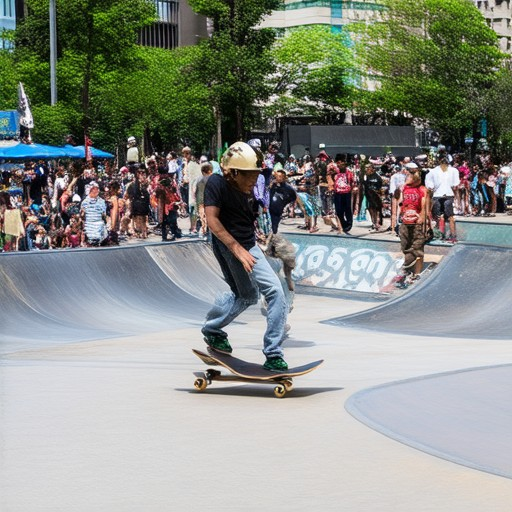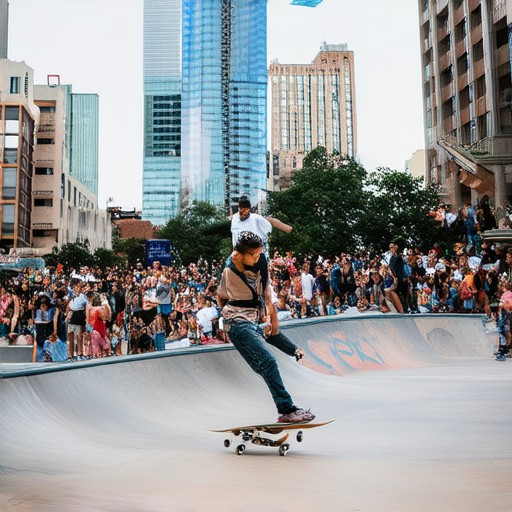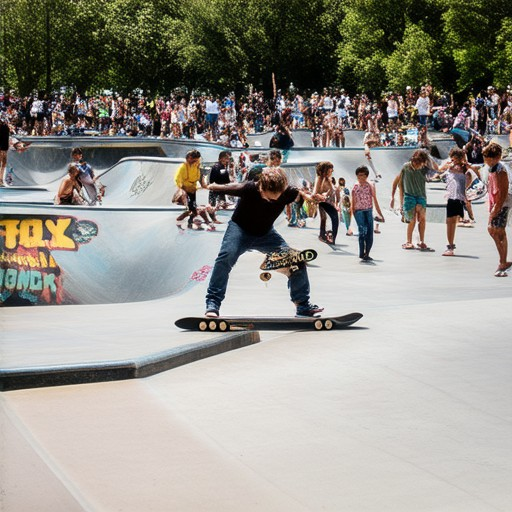Skateboarding is more than just a recreational activity; it is a vibrant cultural phenomenon that has shaped communities worldwide. With its deep-rooted history and unique subcultures, skateboarding has become a symbol of self-expression, creativity, and resilience. From its humble beginnings as a beachside pastime to its evolution into a global movement, skateboarding has left an indelible mark on popular culture. This article delves into the origins of skateboarding, explores its values, examines its subcultures, and investigates its impact on society. By uncovering the stories behind skateboarding’s growth and its influence on art, fashion, and social movements, we aim to provide a comprehensive understanding of this dynamic culture.

How Does Skateboarding Affect Culture?
Skateboarding has had a profound impact on culture, shaping its identity into a vibrant, globally recognized phenomenon. Below are the key ways skateboarding influences society:
-
Cultural Expression : Skateboarding serves as a medium for self-expression, allowing individuals to showcase creativity through tricks, styles, and personalized setups. It has inspired countless artists, filmmakers, and musicians, contributing to the evolution of urban and street art movements.
-
Rebellion and Individuality : Historically, skateboarding has been associated with rebellion and nonconformity. It challenges traditional norms, encouraging a DIY ethos and fostering a sense of community among skateboarders who share a passion for the sport.
-
Urban Development : In many cities, skateboarding has played a role in the revitalization of public spaces. Skateparks and street spots have become hubs of social interaction, attracting diverse groups and boosting local economies.
-
Global Influence : Skateboarding has transcended geographical boundaries, becoming a universal language of youth culture. Events like the X Games and the Olympics have introduced it to mainstream audiences, further cementing its status as a global icon.
-
Fashion and Lifestyle : Skateboarding has influenced fashion trends, particularly in urban wear. Brands and styles inspired by the sport continue to shape contemporary clothing, footwear, and accessories.
-
Music and Art : Skateboarding has fostered collaborations between artists and skateboarders, leading to murals, music videos, and other creative projects. Many musicians and bands credit skateboarding as a source of inspiration.
-
Community Building : Skateboarding fosters a strong sense of belonging among its participants. Local skate shops, competitions, and online communities connect people who share a love for the activity, creating a supportive network.
-
Sustainability and Social Issues : Skateboarding companies and organizations are increasingly focusing on sustainability and social responsibility. Initiatives aimed at reducing waste, supporting fair labor practices, and addressing environmental concerns are becoming common.
-
Youth Empowerment : Skateboarding programs are often used as tools for youth development, offering opportunities for physical fitness, leadership training, and personal growth in underserved communities.
-
Technological Innovation : The sport has driven advancements in technology, particularly in the design of skateboards, protective gear, and video editing software used to document and share skateboarding experiences.
Skateboarding continues to evolve, leaving an indelible mark on culture and inspiring future generations. Its influence extends far beyond the board, touching upon art, fashion, music, and societal values.
Values of Skateboarding Culture
The skateboarding culture is defined by a unique set of values that go beyond the physical activity itself. These values shape the community, the way skaters interact, and their approach to life. Here are the primary values:
-
Freedom : Skateboarders embrace a free-spirited lifestyle, often rejecting traditional constraints. They express themselves through their actions and clothing, reflecting a rejection of societal norms.
-
Creativity : Skateboarding encourages innovation. Skaters constantly explore new tricks and ways to manipulate the board, fostering a culture that values originality and artistic expression.
-
Resilience : The process of learning to skateboard is fraught with falls and setbacks. This perseverance teaches skaters to overcome obstacles and view challenges as opportunities for growth.
-
Community and Camaraderie : Skateboarding brings people together. Skaters often collaborate, share tips, and support each other, forming tight-knit communities that extend beyond the board.
-
Exploration and Curiosity : Skaters are naturally curious and adventurous. They seek out new spots to skate, explore different cultures, and push their limits, driving constant progression.
-
Progression : The pursuit of getting better is a significant motivator. Skaters are always looking to improve their skills, whether through practice or experimenting with new techniques.
-
Respect for Public Spaces : Many skaters take pride in maintaining the areas they frequent, respecting local laws and regulations to ensure continued access to these spaces.
These values collectively contribute to a vibrant and dynamic skateboarding culture, characterized by its rebellious spirit and shared passion for the activity.

What Culture Does Skateboarding Come From?
Skateboarding culture has deep roots in Southern California, particularly Los Angeles and San Diego, during the 1970s. This era marked the emergence of skateboarding as a distinct subculture, heavily influenced by the surf culture of the time. Surfers sought ways to stay active during flat waves, leading to the development of early skateboards.
The 1980s saw the rise of iconic skateboard brands like Santa Monica-based Skateboards Inc., which popularized the “kickflip” maneuver. This period also introduced legendary figures like Stacy Reiss and Rodney Mullen, who became synonymous with the sport and helped shape its cultural identity.
Key Components of Skateboarding Culture:
- Artistic Expression : Skateboarding has always been a canvas for creativity, with skateboard designs ranging from bold graphics to minimalist aesthetics.
- Music and Fashion : Skate culture often overlaps with music genres like punk rock and hip-hop, influencing fashion trends such as baggy jeans and vibrant streetwear.
- Community and Lifestyle : Skateboarding fosters a sense of community, with skaters gathering at local skate parks to share tricks and stories. This camaraderie has led to the creation of global skate communities.
Global Influence:
Skateboarding has transcended borders, becoming a universal language of youth culture. Countries like Brazil, Japan, and Europe have embraced skateboarding, blending local flavors with the original American roots. This global adoption has turned skateboarding into a symbol of freedom and self-expression.
Kickflip Boards, a leader in skateboard resources, highlights the evolution of skateboarding from its humble beginnings to its current status as a worldwide phenomenon. Their platform offers insights into the latest trends, techniques, and gear, helping skaters of all levels stay informed and connected.
Skateboarding continues to evolve, embracing new technologies and inspiring countless individuals around the world. Its cultural impact extends far beyond the board, shaping fashion, music, and even urban design.

Subculture of Skateboarders
Skateboarding has evolved beyond just a sport into a vibrant subculture that embraces creativity, self-expression, and a unique lifestyle. This subculture is defined by its shared values, distinct fashion, music preferences, and a strong sense of community.
Key Elements of Skateboarder Subculture
- Creativity and Artistry: Skateboarders often view their boards as canvas for self-expression. Street skating particularly emphasizes creativity, with tricks requiring precision and originality.
- Risk and Rebellion: The act of skateboarding inherently involves risk, appealing to those who enjoy pushing boundaries and defying conventional norms.
- D.I.Y. Ethos: Many skateboarders embrace a “do-it-yourself” mindset, from building custom skateboards to modifying equipment for personal style.
- Community and Friendship: Skateboarding fosters a sense of belonging among participants, with local skate parks serving as hubs for social interaction and mutual support.
Historical Context
The skateboarding subculture traces its roots to the late 1940s and early 1950s, with surf culture influencing the development of longboards. By the 1970s, skateboarding began to gain popularity, driven by iconic figures like Tony Alva and Stacy Reiss. This era marked the emergence of skateboarding as a countercultural activity, opposing mainstream sports’ rigid structures.
Fashion and Identity
Skateboarders have developed a distinctive style, characterized by baggy clothes, graphic tees, and accessories like beanies and fingerless gloves. Brands catering to this subculture, such as Kickflip Boards , offer products tailored to skateboarders’ needs and tastes.
Music and Lifestyle
The skateboarding subculture is deeply intertwined with punk rock and surf music. Artists like Dead Kennedics and The Misfits resonate strongly within the scene, reflecting the rebellious spirit of skateboarders.
Notable Skaters and Influencers
Icons like Rodney King, Tony Hawk, and Jamie Andrade have redefined skateboarding through their innovative tricks and style. Their influence extends beyond the board, shaping the subculture’s identity and inspiring new generations.
Economic Impact and Market Trends
According to recent studies, the global skateboard market is projected to grow steadily, driven by increasing participation among youth and the rise of streetwear fashion. Brands like Kickflip Boards play a crucial role in supporting this growth by providing high-quality products and fostering a sense of community among skateboarders.
Conclusion
Skateboarding’s subculture is a dynamic blend of art, rebellion, and community. It continues to evolve, attracting individuals who share a passion for pushing boundaries and embracing a unique lifestyle. Whether on the streets or in skate parks, skateboarders remain united by their love for the sport and its associated culture.
How Does Skateboarding Create Community Within a Culture?
Skateboarding fosters a unique sense of community within various cultures by bringing individuals together through shared interests and experiences. Here’s how it builds connections:
- Inclusivity and Diversity: Skateboarding transcends age, gender, ethnicity, and socioeconomic backgrounds, creating a space where everyone feels welcome. It promotes camaraderie by breaking down barriers and encouraging collaboration.
- Shared Experiences: Skaters often gather at local skate parks or spots, sharing tricks, tips, and stories. These interactions strengthen bonds and create a sense of belonging among participants.
- Local Spot Culture: Many communities invest in public skate parks or DIY spots, becoming hubs where locals and visitors converge. These spaces become symbols of cultural identity and teamwork.
- Events and Competitions: Skateboarding contests and jam sessions bring people together, fostering competition while also building friendships and shared pride in the culture.
- Online Communities: Forums, social media groups, and websites like Kickflip Boards connect skaters globally, enabling them to share knowledge, inspire each other, and stay updated on trends.
- Cultural Exchange: Skateboarding often serves as a bridge between different cultures, introducing people to new perspectives and fostering mutual respect. It’s a universal language that transcends borders.
Skateboarding’s ability to unite people across differences makes it a powerful tool for building community within any culture, fostering connections that extend beyond the board.

What is the stereotype of skateboarders?
The stereotype of skateboarders often conjures images of rebellious teenagers, typically boys, wearing baggy clothes, and skating with a casual, carefree attitude. This perception is partly rooted in reality, as many skateboarders do embrace a unique style of dress and behavior that sets them apart from mainstream norms. However, this stereotype is just one facet of a broader, richer identity.
Why Does the Stereotype Exist?
- Clothing and Style: Skateboarders are often associated with specific fashion choices, such as skate shoes, hoodies, and loose-fitting jeans. These outfits reflect a particular lifestyle and have become synonymous with the culture.
- Music Taste: Skateboarding has historically been tied to punk rock and surf culture, which influences the music preferences of many skateboarders.
- Social Dynamics: Skateboarders often form tight-knit communities, hanging out at skate parks and sharing a sense of camaraderie. This social aspect contributes to the perception of a unified group.
Beyond the Stereotype
While the rebellious image is a common stereotype, it’s important to recognize that skateboarders come from diverse backgrounds and have varying interests. Many skateboarders are active in their communities, pursue academic or professional goals, and contribute positively to society. The culture is inclusive and welcoming to individuals of all ages, genders, and skill levels.
A Balanced Perspective
Skateboarding culture is vibrant and multifaceted, encompassing not just street skating but also artistic expressions like graffiti and BMX riding. It’s a lifestyle that blends physical activity with creativity and social interaction. While the stereotype may emphasize certain traits, it’s essential to appreciate the diversity within the skateboarding community.
Conclusion
Skateboarders are often seen through the lens of rebellion and individuality, but this stereotype only scratches the surface of a complex and dynamic culture. Whether you’re a seasoned skater or new to the scene, skateboarding offers a unique way of life that transcends simple stereotypes. Embrace the diversity and find your own path within this exciting community.




0 Comments